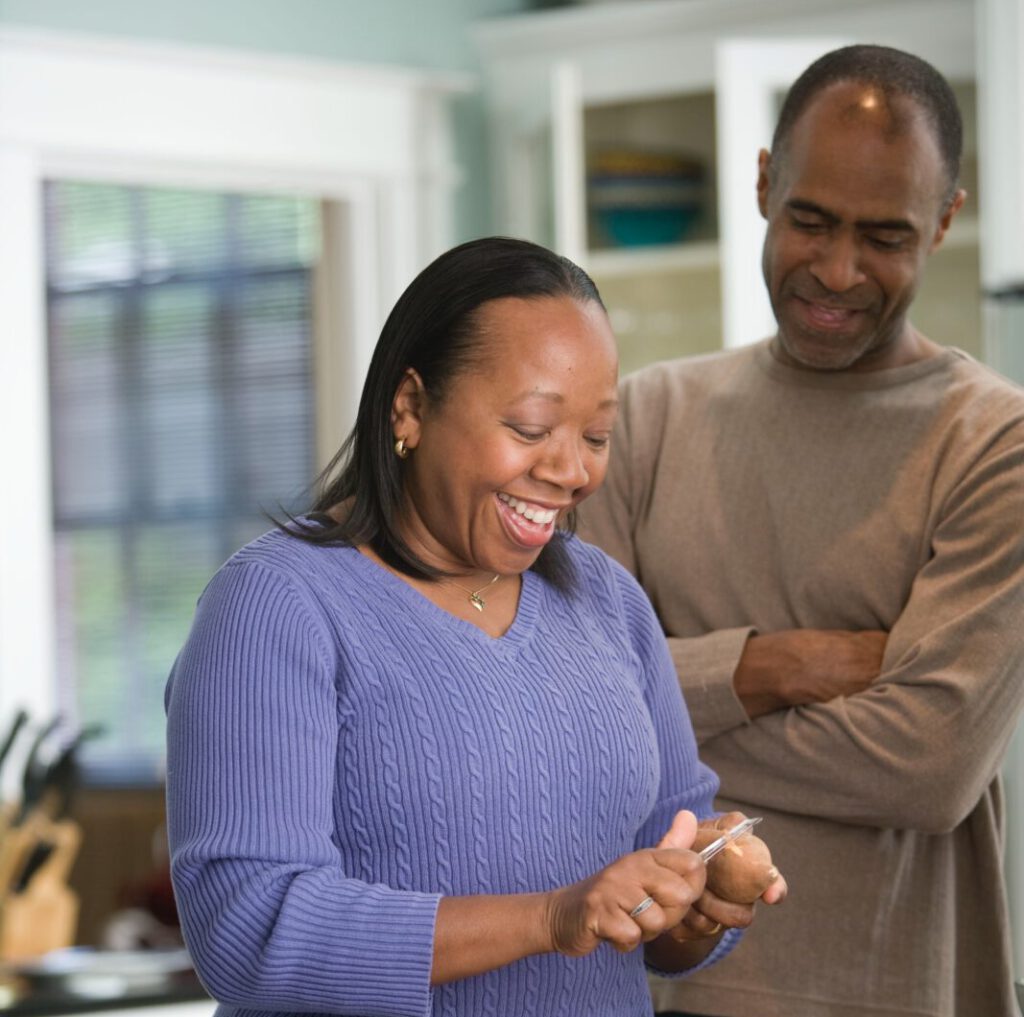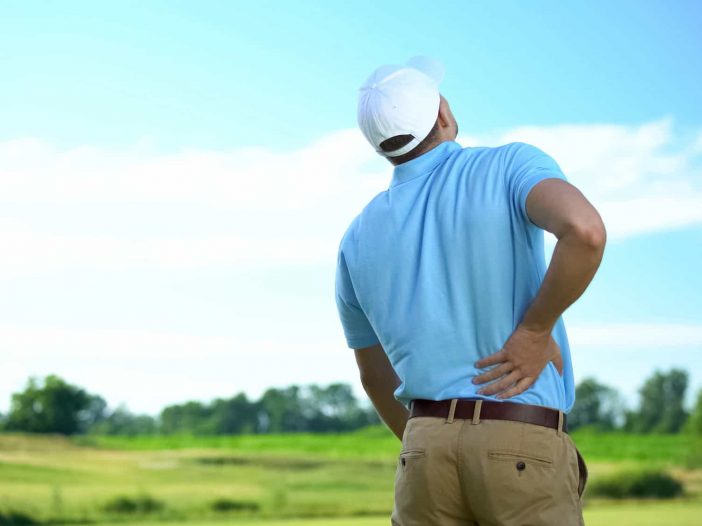
Golf is more injurious than most people realize. Without the proper precautions and knowledge, you can damage yourself and cause significant chronic pain through golf-related injuries. Here’s what you need to know.
When it comes to popular sports, golf is given the most flak. Some proclaim that playing golf simply ‘ruins a good walk’. In contrast, others call the Eastern-Scottish pastime an “old man’s game” that requires little-to-no exercise, and minimal effort.
The usual stereotype for golfing revolves around a ‘casual’ activity for people of all ages to enjoy on the weekends, whereas the archetypal golfer is portrayed as a retired businessman who casually spends time at the golf club to showcase his Range Rover to fellow snobs.
One of those aspects is certainly true. Golfing really is for all ages, but it’s not quite the ‘walk in the park’ that armchair experts declare. And as for the Range Rover snobs, well, you get them in every sport!
For those who don’t have much experience on the golf course, the sport can come across as a slow-paced venture that involves some walking with some swings of a club (and some swearing) every now and then.
However, this is far removed from the truth. Prepare yourself for a shock. There’s a reason why golf was the sport of choice for Sean Connery.
Golf: The Injurious Reality
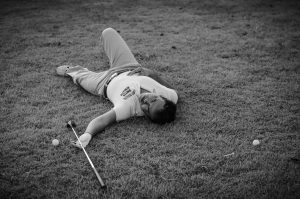
Want to take a guess at the sportspeople we usually see most often? You got it in one. Golfers.
In reality, golf is not for the unfit or faint-hearted. A proper golf swing is one of the most strenuous and violent movement patterns your body can be subjected to. Playing golf at a serious level radiates tremendous forces and stress through the body.
Golf can be a very demanding and physical sport. If you don’t understand the intricacies of your body’s joints and muscles, then you can quickly do yourself harm.
Playing golf may appear like a leisurely and undemanding pursuit, but it requires brains, muscles, and stamina. It’s for these reasons that James Bond, as a fictional character, chose to play golf. And why, consequently, Sean Connery did, too.
Suddenly, golf isn’t quite the “old man’s game” it’s made out to be. And there are dozens of injuries that can befall the unwary or the unlucky.
Golf-Related Injuries
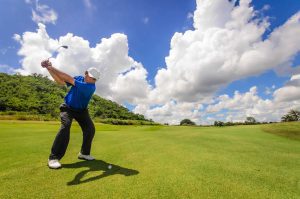
Golf-related injuries can range from ankle and foot problems, to twisted backs, strained rotator cuffs, and heavy bouts of chronic knee pain. It’s not uncommon for golfers to develop painful rounds of tennis elbow and wrist pain, either.
As if that’s not enough, you’ve got all the discomfort of muscle and joint pain after swinging a club on uneven surfaces. This can badly affect your shoulder, especially after repeated swings.
However, most commonly, we see folks dealing with low back pain and/or tightness. As a double whammy, not only does this cause discomfort and pain, but it makes participation in daily life (not to mention the sporting activity they love) increasingly difficult.
The Anatomy of Golf-related Injuries
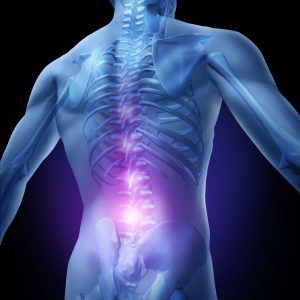
It’s all well and good to hear about the dangers of detrimental golf playing. Still, you need to also understand how your body moves during a golf swing to prevent trauma.
Take a step back and think about how your back moves during a golf swing. There’s a whole load of different turns and stresses being applied to your back muscles.
You’ve probably heard that standard golf tip about “opening your hips” to improve your rotation. This helps to produce more force for your golf swing, aiding your game and reducing your handicap.
Well, doing this “hip turn” inadvertently rotates your spine during your backswing. As if that’s not demanding enough, you then forcefully accelerate and push your body out of this rotated position to hit the ball.
If your back is not adequately prepared (and strong enough) to withstand all this rotation and force, injuries are bound to happen. You may get away with it for a while, but you won’t be immune for very long.
The same story applies to your knees. Think about the way in which you lean and twist on each knee during a golf swing. If you aren’t careful, or act with too much force, then your knee will twist too fast or with excessive exertion. The result? Chronic knee pain that nobody wants.
Some unlucky individuals pair these injuries with injured tendons in their wrists. Like the tendons in your elbow, wrists can suffer from fatigue and strain and become inflamed. Not only can this affect your ability to hold your golf club correctly, but it can also prevent you from performing at all (in severe cases).
How To Prevent Golf-related Injuries
If all this pain doesn’t sound like fun, don’t panic! Golf is good for your body, so long as you take the relevant precautions.
Most golfers utilize a common strategy to prepare their lower back to adequately stretch and warm up before the golf round. You often hear people recommend stretching your hamstrings, shoulders, and hips, before swinging the club.
This is all good advice, and we recommend plenty of stretching before and after your golf rounds. Don’t stop there, though. There is one more “bang for the buck” option to help prevent lower back pain.
Strengthen Your Core Against Golf-related Injuries!

It’s perfectly admirable to stretch as often as possible to improve your hip and lower back mobility. After all, it gives that great feeling of a “nice and mobile” backswing. However, if you are lacking the core strength to support your back in the first place, you are increasing your risk of overall injury.
We often witness people come into our Northeast physical therapy clinic or Coon Rapids branch and tell us the usual horror story. They have worked on improving their flexibility to help with swing mechanics, but they experience no change in ball distance. To add insult to injury, they also now have more back pain than before when they weren’t stretching!
For our back to tolerate all of that rotation and force generation with swinging a golf club, we need to appropriately strengthen our “core.”
Naturally, unless you’ve been in this situation before, you’ll be wondering what we mean by that. What is your “core”?
When we reference the “core,” this includes any muscles in the abdominal region that help provide support to our spine. They keep us standing upright, save us from falling to the side, and help maintain balance.
Most importantly, our core muscles allow our arms and legs to move quickly without the rest of our body falling with it. The prime example used by medical lecturers? You got it in one. A golf swing!
So, if you’re finding yourself frustrated with low back pain during your golf swing, we highly recommend starting a core strengthening program.
Start with some planks. We love the benefits of planking (and side-planking) to engage the exact same muscle groups used during a golf swing.
Start with performing 3-4 rounds of a plank at a time that you can maintain good form. Have the goal to work on planks 3 days a week and progressively add 5-10 seconds every week.
What Can I Do If I Suffer A Golf Injury?

Even when armed with all this knowledge, injuries can still occur. You can never fully tell what the course holds for you, just like any sport.
If you find yourself struggling with back pain, knee pain, wrist pain, elbow pain, or shoulder and neck pain, after walking away from your golf match, get in touch with a physical therapist. In most cases, your doctor will only prescribe painkillers and encourage you to rest. Painkillers only mask the pain and don’t solve the problem.
By turning to a physical therapist, you don’t have to depend on painkillers to cope with daily life. At PRO Therapy, we pride ourselves on getting you back to health, and back on the course!
We won’t generalize your condition or treat you like a number. Instead, we take the time to understand your exact situation and analyze the events leading up to your discomfort.
After we’ve established what’s gone on, we’ll discuss and craft a bespoke treatment plan to ensure that life gets back to normal as quickly as possible. We won’t keep you away from the sport and activities that you love. We want to get you back on track as soon as possible!
More importantly, for breaking the ice, don’t feel embarrassed about reaching out for help. Golfing-related injuries happen all the time – even to seasoned professionals! And who do they turn to for assistance? You got it in one. A physical therapist!
Interested in learning more about how you can improve your core strength to help prevent or eliminate low back pain during a golf swing? Feel free to give us a call at 612-767-9917 to speak directly with one of our expert Physical Therapists.
We have physical therapy clinics in Coon Rapids and Northeast, MN. Get in touch through our contact page anytime. We look forward to helping you!
————————————-
This is an updated version of our previous blog on golf-related injuries and back pain, written by Ben Schacht. You can find the original article here – published on June 1, 2020.
Do You Want to Be in Less Pain?
Maybe you’re left feeling Confused? Skeptical? Fearful? Anxious? Depressed? You’ve sought advice from other healthcare professionals, maybe even a Physical Therapist in the past, but nothing they seemed to say or do helped solve your problem.
